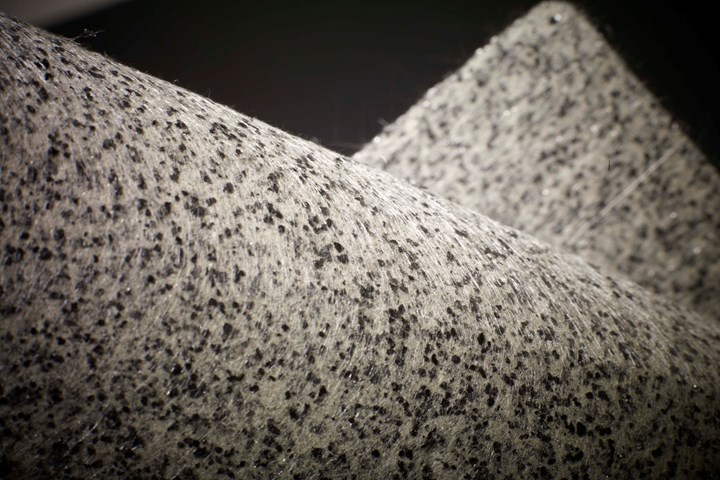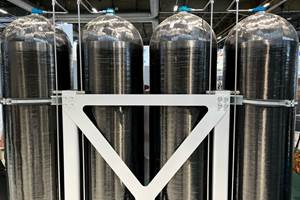TFP Tecnofire materials demonstrate effectiveness for rail applications
Tecnofire fire protection materials enable composites manufactured from a non-FST epoxy carbon fiber prepreg to pass key elements of the EN45545-2 rail standard.

Photo Credit: Technical Fibre Products Ltd
Tecnofire, Technical Fibre Products Ltd.’s (TFP, Burneside, U.K.) range of intumescent fire protection materials, have recently demonstrated their effectiveness for use in composite applications in the rail sector. Designed to protect underlying structures during a fire while reducing smoke and heat release, Tecnofire enables composites manufactured from a non-fire, smoke and toxicity (FST) epoxy carbon fiber prepreg to pass key elements of the EN45545-2 rail standard with a HL2 R1 rating.
The successful demonstration results from a three-year study of these materials, carried out by the University of Nottingham Ningbo China, which focused on the incorporation of Tecnofire into composites in order to pass fire tests which are part of the EN45545-2 standard required in rolling stock applications for interior paneling (R1). According to TFP, three types of composite were investigated; a standard non-FST-rated epoxy carbon fiber prepreg-based composite, a standard non-FST epoxy carbon fiber prepreg-based sandwich composite and a polyester resin vacuum infused composite window panel for an underground train. All three parts were reportedly fabricated and subjected to stringent fire testing to assess their performance to specific EN44545 tests.
According to the study, the fire tests carried out were ISO 5660-1 (MARHE (kW/m2)), ISO 5659-2 (Ds(4), VOF4 (min) and CIT at 8 min. The control panels not incorporating the Tecnofire material achieved HL1 (R1), which is the lowest level of performance to EN45545-2. For the three different composite structures incorporating Tecnofire, all MARHE (kW/m2), Ds(4), VOF4 (min) results successfully achieved the EN45545-2 HL2 R1 requirement and all CIT at 8 min results achieved the EN45545 (higher rated) HL3 requirement.
This success demonstrates the effectiveness of Tecnofire in providing the required level of fire protection to the structure; incorporating a layer of Tecnofire intumescent veil reportedly improved the FST performance of the composite part from HL1 to HL2 (R1). According to the study, HL2 R1 rating makes the composite parts suitable for use in interior paneling in the majority of trains currently manufactured. In the case of the window panel, the results were particularly notable, as the fire test results were all very close to the HL3 rating, and the part also surpassed all the mechanical requirements for use in an underground train.
In addition to its successful performance in fire testing, the company notes Tecnofire’s other advantages such as being easy to incorporate at the surface of the composite before processing, is readily infusible, requires no additional processing steps and the required mechanical properties can still be met. It is said to also potentially remove the need for specialist fire retardant resins to be used. TFP adds that the material has been used extensively in a range of industries and has been specified for use in utility poles, bridges, fire doors, aircraft and mass transport applications such as buses, trams and trains following successful fire testing.
A more detailed discussion of the EN45545-2 results will be presented as part of a CW webinar titled “Enabling Composites to Pass Stringent Fire Tests Using Advanced Nonwovens” on November 24, 2020 at 2 p.m. EST. More details can also be found on Technical Fibre’s website, along with a comprehensive flyer on the testing which can be accessed from the download section.
Related Content
Jeep all-composite roof receivers achieve steel performance at low mass
Ultrashort carbon fiber/PPA replaces steel on rooftop brackets to hold Jeep soft tops, hardtops.
Read MoreCarbon fiber, bionic design achieve peak performance in race-ready production vehicle
Porsche worked with Action Composites to design and manufacture an innovative carbon fiber safety cage option to lightweight one of its series race vehicles, built in a one-shot compression molding process.
Read MoreRecycling hydrogen tanks to produce automotive structural components
Voith Composites and partners develop recycling solutions for hydrogen storage tanks and manufacturing methods to produce automotive parts from the recycled materials.
Read More“Structured air” TPS safeguards composite structures
Powered by an 85% air/15% pure polyimide aerogel, Blueshift’s novel material system protects structures during transient thermal events from -200°C to beyond 2400°C for rockets, battery boxes and more.
Read MoreRead Next
Tecnofire adds fire resistance to transportation and infrastructure applications
Intumescent nonwoven veils improve the fire performance of composites in bridge, bus, building, marine and aircraft structures.
Read MorePlant tour: Daher Shap’in TechCenter and composites production plant, Saint-Aignan-de-Grandlieu, France
Co-located R&D and production advance OOA thermosets, thermoplastics, welding, recycling and digital technologies for faster processing and certification of lighter, more sustainable composites.
Read MoreDeveloping bonded composite repair for ships, offshore units
Bureau Veritas and industry partners issue guidelines and pave the way for certification via StrengthBond Offshore project.
Read More
























